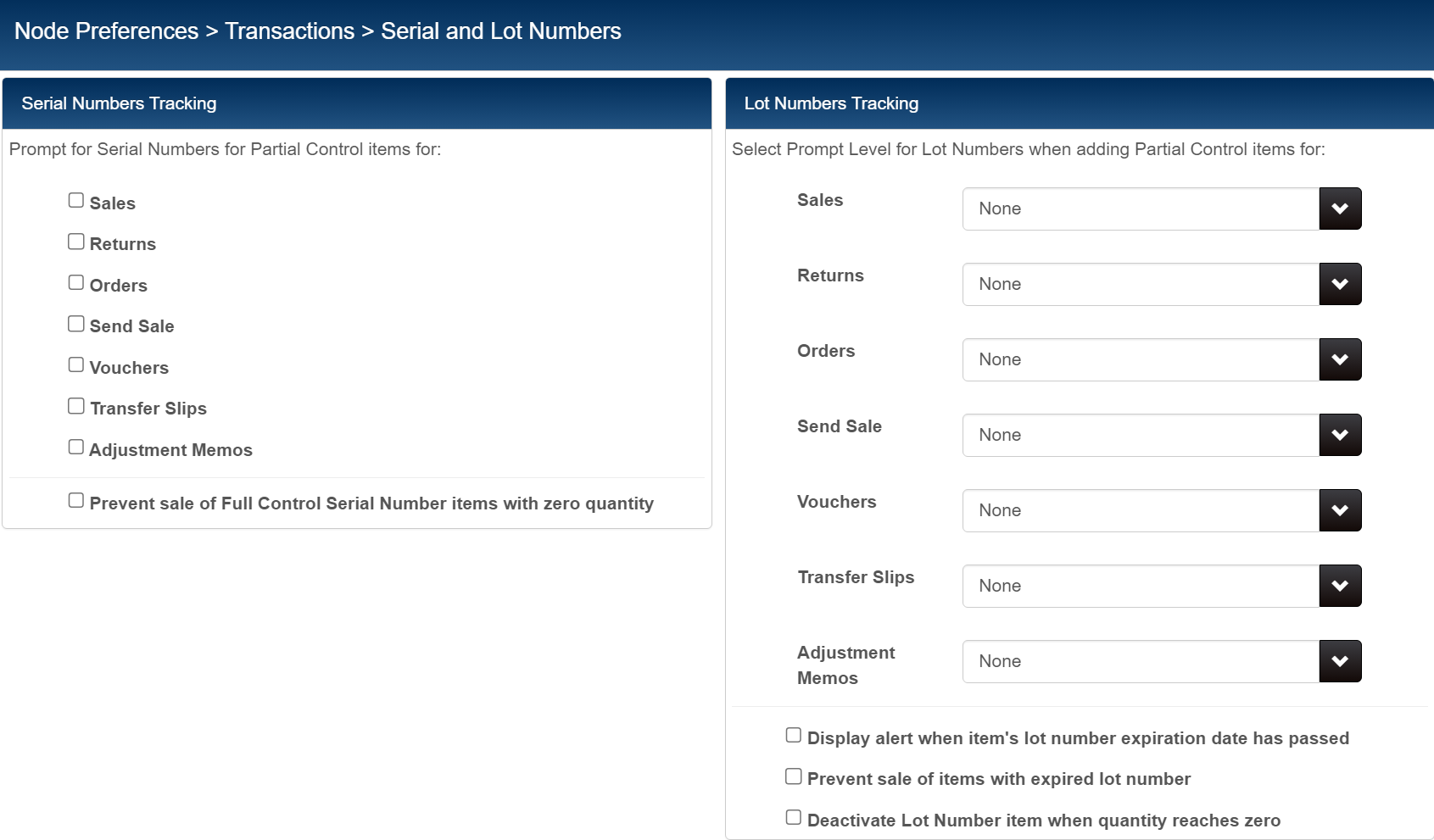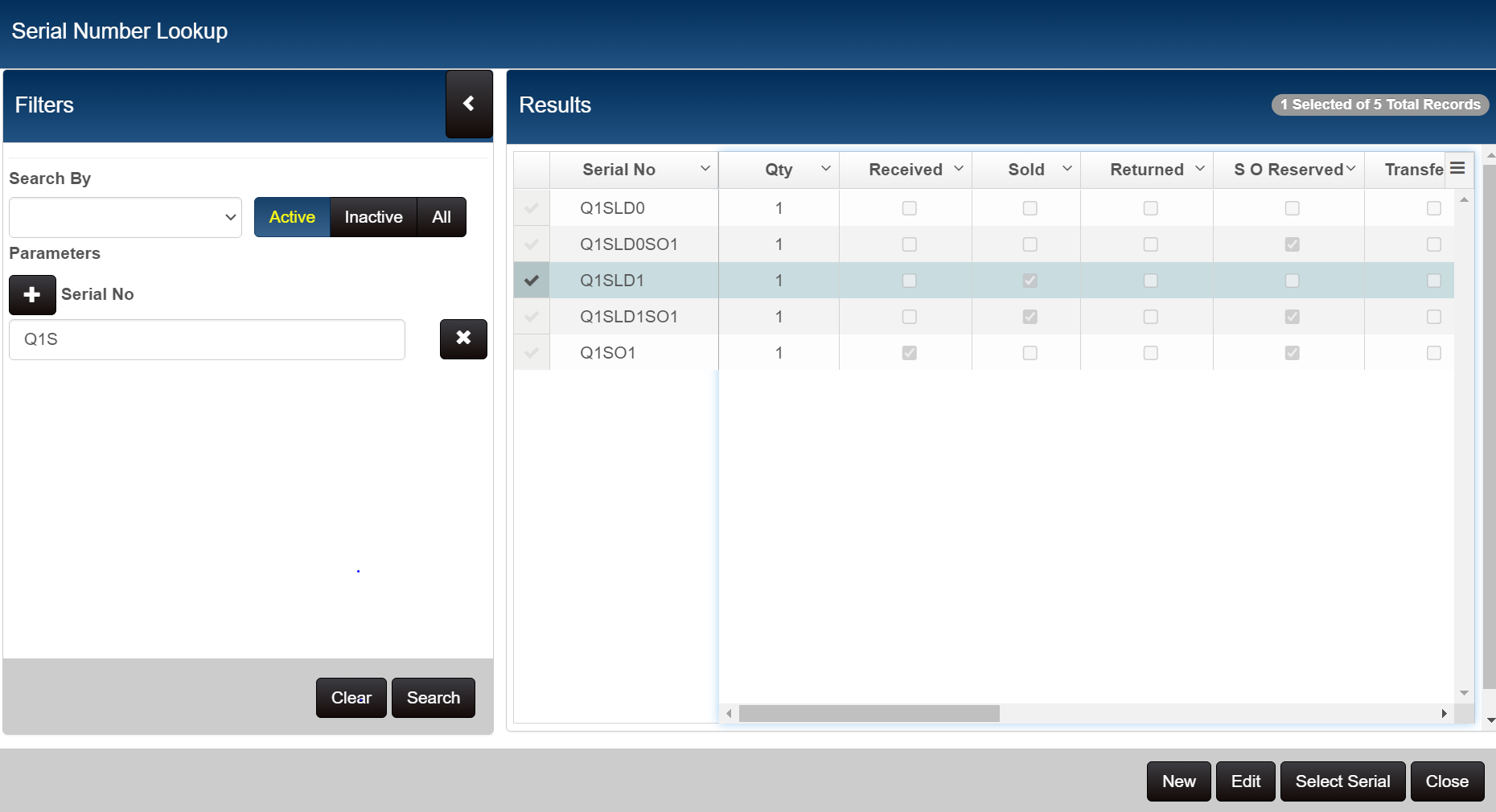Serial and Lot Numbers
Prism 1.14.7 User's Guide Chapter 30. Serial/Lot Tracking PDF
Prism 2.3 User's Guide Chapter 30. Serial/Lot Tracking PDF
Serial and lot numbers provide additional ways to track items, separate from other identifiers like UPC or ALU.
- A serial number is a unique code (on the package or unit itself) that identifies otherwise identical individual units from a single manufacturer. Although called a serial number, it may include letters or other symbols. serial numbers are an important deterrent against theft and counterfeit products.
- Lot numbers do not have to be unique for each unit. Lot numbers are often used to trace the people and parts involved in the manufacturing of a product. For example, customers who buy products that have down feathers (e.g. sleeping bags, jackets) can enter the lot number on trackmydown.com to find detailed information about the lot and verify the quality. You can optionally assign an expiration date to lot numbers. This is useful for things like pharmaceuticals or bulk goods. Lot numbers can be used when contacting the manufacturer about goods received.
Note: An item can be assigned both a serial number and a lot number, if necessary.
About Full vs Partial Control of Serial and Lot Numbers
Full Control - Entry of Number Required: When a full control item is entered on a document, entry of a serial or lot number is required. For example, if you list a serial number item with a quantity of "3" then the user must enter three unique serial numbers, one for each unit. To make an existing item a full-control serial/lot number item, the item's OH Qty must be zero.
Partial Control - Entry of Number Optional: When it comes to partial control items on documents, entry of a number is optional. For partial control, you can select the specific document types where a prompt will be displayed when a serial/lot number item is listed (the prompt is always displayed for full-control items).
About Decimal Quantity Items and Serial/Lot Numbers
Once a Serial/Lot Type (full control or partial control) is selected, the Quantity Decimals flag cannot be edited.
Once an item has been made a decimal qty item (Quantity Decimals flag selected), the Serial/Lot Type cannot be changed.
Basic Steps for using Serial/Lot Numbers
- Configure Serial and Lot Number-related permissions and preferences.
- For serial and lot number items, set the Serial Type/Lot Type field to Full Control or Partial Control as needed.
- Enter numbers when receiving serial/lot number items on vouchers. Alternatively, add numbers using the Serial Numbers and Lot Numbers buttons in Inventory.
- When a serial or lot number item is entered on a transaction, a prompt will be displayed. Type or scan the number for each unit being purchased or returned. (Note: Entry is optional for partial-control items)
The remainder of this topic explains each of the key steps in more detail.
Serial and Lot Number Preferences (Node Preferences > Transactions > Serial and Lot Numbers)
Serial Number Tracking
Select which document types will display the "Enter Serial Number" prompt when a user adds or edits a partial control item: Sales, Returns, Orders, Send Sale, Vouchers, and/or Transfer Slips. For partial control items, even if the prompt is displayed, entry of a number is optional.
Prevent Sale of Full Control Serial Number items with zero quantity
In Prism 2.3 and later, the "Prevent Sale of Full Control Serial Number items with zero quantity" preference when enabled prevents the sale of full-control serial number items if the number has a zero OH Qty. Enabling this preference can help prevent serial numbers from going into a negative OH Qty. If "Prevent sale of Full Control Serial Number items with zero quantity" is enabled, a full-control serial number item must have a positive OH Qty value for the number to be sold. Adding a full-control serial number with an OH Qty of zero results in a red toast message explaining the number is not available and the entry will be cleared.
Sample Node Preferences > Transactions > Serial and Lot Numbers:
Lot Number Tracking
The interface in the Lot Numbers area is slightly different than the UI for serial numbers. In the Lot Number Tracking area, for each document type, select an option from the drop-down menu. Refer to the following table for information about the checkbox preferences for lot numbers:
| Lot Number Tracking Setting | Description |
|---|---|
| None | No prompt is displayed for lot number items under partial control. |
| Prompt | A prompt to the user is displayed; however, entry is not required |
| Prompt and Require | A prompt is displayed and entry of a lot number is required |
Lot Number Preferences
| Preference | Description |
|---|---|
| Display alert when item's lot number expiration date has passed. | If selected, when a lot number's Expiration Date is passed, and a user lists the item, a warning will be displayed. |
| Prevent sale of items with expired lot number | If selected, when a lot number's Expiration Date is passed, and a user lists the item, an error is displayed. |
| Deactivate Lot Number item when quantity reaches zero | If selected, when the OH Quantity of a lot number item reaches zero, the item's Active flag will be cleared, making the item inactive. |
Grid Formats
Serial and lot number fields can be included in the grids on various document and record types. To configure grid format preferences, go to Node Preferences > Grid Formats. Serial and lot number fields can be added to grid formats for the following areas: Advanced Item Search (Serial Type/Lot Type only), Inventory (Serial Type/Lot Type only), PI Sheet Filters (Serial Type/Lot Type only), Transfer Order Items (Serial Type/Lot Type only), Transfer Slip Items, Vouchers
Permissions for Serial/Lot Numbers
The following permissions enable you to control employee access to serial/lot numbers in Prism.
| Permission | Description |
|---|---|
| Adjustment Memo - Allow bypass of full control serial number entry | When a user tries to update a memo before all numbers for full-control items have been entered, a prompt is displayed: Not all full control serial numbers have been entered. Continue with update? Only users who belong to a group that is assigned the "Allow bypass of full control serial number entry" permission can continue with the update. |
| Adjustment Memo - Allow bypass of full control lot number entry | When a user tries to update a memo before all numbers for full-control items have been entered, a prompt is displayed: Not all full control lot numbers have been entered. Continue with update? Only users who belong to a group that is assigned the "Allow bypass of full control lot number entry" permission can continue with the update. |
| Serial and Lot Numbers - Allow Use Before Receiving | Allow group members to use a serial/lot number before the item has been received on a voucher. This permission is useful if Associates sometimes have to sell serial or lot number items before the voucher for the items has been updated. |
| Serial and Lot Numbers - Allow Use When Already Received | Allow group members to use a serial or lot number that has already been received. |
| Serial and Lot Numbers - Allow Use When Not In Inventory | Allow group members to use a serial or lot number that is not assigned to the item's inventory record. |
| Serial and Lot Numbers - Allow Use When on Another Order Item | Allow group members to use a serial or lot number that has already been assigned to an order item. For example, perhaps a number was assigned to an order item but the customer never fulfilled the order, or didn't fulfill the order in a timely fashion. This permission will allow the number on the order to be used for a sale. |
| Inventory - Assign Lot Type | Allow group member to edit the Lot Type field, including to change an existing regular item to a partial or full-control lot item. |
| Inventory - Assign Serial Typ | Allow group member to edit the Serial Type field, including to change an existing regular item to a partial or full-control serial item. |
| Inventory - Edit OH Qty Without S/LN | Allow group members to change the OH Qty for a serial/lot item without entering a number for the quantity. If a user has this permission, the user can leave the number empty and simply click "Save" in the Enter Serial Number prompt. |
About the "Edit Item Detail" permission
The POS > Edit Item Details permission controls a user's ability to use the Details button to edit line items on transactions. The Edit Item Details permission enables a user to edit OH Qty and serial/lot numbers in Item Details on transactions, but the permission does not grant permission to edit serial and lot numbers in Inventory. To edit numbers in Inventory, the user must have those specific Inventory permissions.
Bypass Full-Control Serial Numbers, Lot Numbers on Adj Memos
The following permissions enable retailers to bypass full-control serial and lot number tracking on adjustment memos. These permissions make it easier for users to create quantity adjustments if the serial or lot number is unavailable.
| Permission | Description |
|---|---|
| Adjustment Memo - Allow bypass of full control serial number entry | When a user tries to update a memo before all numbers for full-control items have been entered, a prompt is displayed: Not all full control serial numbers have been entered. Continue with update? Only users who belong to a group that is assigned the "Allow bypass of full control serial number entry" permission can continue with the update. |
| Adjustment Memo - Allow bypass of full control lot number entry | When a user tries to update a memo before all numbers for full-control items have been entered, a prompt is displayed: Not all full control lot numbers have been entered. Continue with update? Only users who belong to a group that is assigned the "Allow bypass of full control lot number entry" permission can continue with the update. |
Entering Serial Numbers on Documents
Users can enter serial and lot number on documents in two ways:
- Via a prompt displayed when the item is first listed
- Via Item Details dialog
A prompt will be display if the item is under full-control, or if the item is under partial control and preferences are configured to display a prompt for the current doc type. The user can scan (or type) the number into the prompt and click OK. Note: Purchase orders and transfer orders, as planning documents, do not allow users to enter serial or lot numbers
Entering Multiple Serial Numbers for Full Control Items
If the customer is purchasing multiple units of a serial number item, the displayed dialog will allow the user to scan/type a number for each quantity listed.
Entering Multiple Serial Numbers for Partial Control Items
Add a partial control serial number item to a document.
Add a SN to the item.
Add the partial control serial number item to the document again.
You can now add a SN to both items.
Note: Items are split into multiple rows if the item is full control or has a serial number already.
Adding a New Serial Number on Document
If you enter a number that is not found in the item's Inventory record, then Prism will ask if you want to add the item. You have three options in this dialog:
- Yes: Adds the number to the store's database.
- No: Does not add the number to the store's database.
- Lookup: Takes the user to the Serial Number lookup screen so the user can search among the numbers assigned to the item.
Note: If you originally entered the number by typing and you see the message above, confirm you typed the correct number.

Duplicate Serial Number Entry
If you mistakenly scan or type the same serial number, the dialog will display an alert. You should scan or type the correct (non-duplicate) serial number.
Entering Serial and Lot Numbers in Item Details on Transactions
Users with the required permission can edit Item Details and change the serial or lot number currently assigned to an item. You can use this method if the item is partial control item and a number is available but wasn't entered in the prompt when the item was first listed.
Serial/Lot Numbers on Send Sale Transactions
When listing serial/lot items on a send sale, the user is not required to enter a number at the selling store, even for full control items. The serial or lot number will be entered by the user at the fulfillment store when the customer picks up the merchandise. When you create send sale, the quantity will become a negative quantity at the selling store. When the send sale is fulfilled, the quantities will balance out and ECM Communication will update the store quantities accordingly.
Serial/Lot Numbers on Adjustment Memos
The process of entering serial and lot numbers on quantity adjustment memos is different from other documents. This is because the user could be adjusting the quantity up or down. In addition, the user interface for entering serial numbers works differently than for lot numbers. This section will show both.
Entering Serial Numbers on Quantity Adjustment Memos
1. Scan the item's UPC to list it on the adjustment memo.
2. Enter the Adj Qty and press
3. Prism opens up Item Details with the Serial Numbers tab displayed. There will be one or more blank rows based on the difference between the Orig Qty and Adj Qty on the memo item list for that serial number item. The Adj Qty for each row is set to "1" or "-1" based on whether the quantity is being adjusted up or down and cannot be changed.
4. Scan or type a serial number. You can search for a number by clicking the Search button (magnifying glass). The Note field is optional.
5. Click OK after you have added numbers for each quantity being adjusted.
Sample Serial Numbers tab in Item Details with a line for each Adj Qty:
Searching for a Serial Number
If you click the Search button, a screen for selecting and entering filter criteria is displayed. Currently the only available filter element is Serial No. The operator is not shown but it is set to CONTAINS and cannot be changed.
Enter or scan all or part of a number and click Search.
In the Results list, select a number and then click the Select Serial button.
Sample Serial Number Lookup modal for quantity adjustment memo with number selected and the "Select Serial" button enabled:
Entering Adjusted Quantity on Details tab
On the Details tab, users can enter the Adjusted Quantity for the item. Users can then navigate to the Serial Numbers tab and enter the number(s) for the units being adjusted.
Entering Lot Numbers on Quantity Adjustment Memos
When entering lot numbers on adjustment memos, instead of a separate line for each Adj Qty (like for serial numbers), you will see a single line set to the total Adj Qty. Users must enter one number at a time and manually adjust the Adj Qty to "-1" or "1" (based on whether decreasing or increasing item quantity) in order to enable the UI element that allows for entry of another number.
In the sample memo below, the Orig Qty is 30 and the Adj Qty is 28 so item quantity is being decreased by 2.
Sample quantity adjustment memo that decreases item quantity by 2:
When you enter an Adj Qty different from the Orig Value and press the
This example decreases item quantity, so manually change the Adj Qty to "-1" and press
Click the Add button. Another row opens. Enter another number and make sure the Adj Qty is -1 if decreasing quantity (or "1" if increasing quantity).
Repeat the process until the Entered Qty values are balanced.
Serial Numbers in Inventory
This section has information about working with serial numbers in Prism Inventory.
Serial Type/Lot Type
The Serial Type and Lot Type fields indicate whether an item uses full control or partial control. Full control requires entry of a number; partial make entry of a number optional.
View/Add/Edit Item Serial Numbers
The Serial Numbers button in the Inventory > Item Detail UI provides access to a dialog for viewing/adding/editing numbers. To edit the list of serial/lot numbers, you cannot be in edit mode. Save any changes, then click the Serial Numbers or Lot Numbers button to edit the list.
1. Navigate to Inventory > Item Details for the item.
2. Click the Serial Numbers button.
3. The serial numbers currently assigned to the item for the user's assigned store are displayed. Click New to add a new number, or click Edit to edit a number.
4. Click the Save button to return to the Inventory screen.
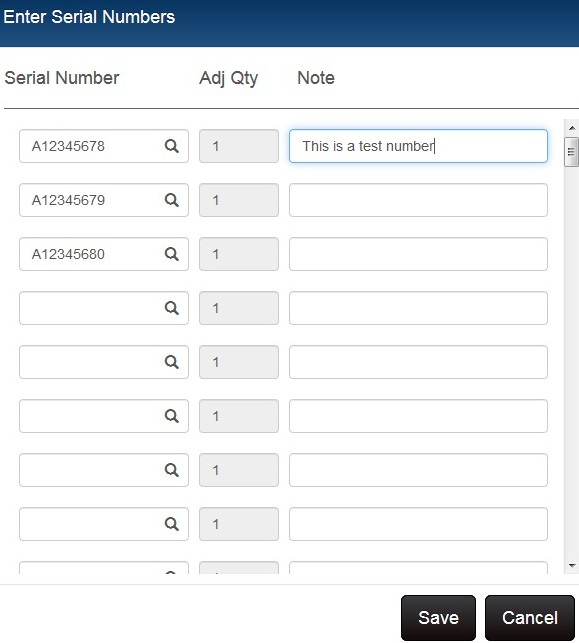
Search for a Number
- Navigate to Inventory > Item Detail for the item and click the Serial Numbers button.
- A list of numbers for the item is displayed. In the Search By dropdown, select Serial No.
- Enter search criteria (e.g. the first few characters of the number).
- Click Search.
- The results are filtered to match the entered criteria.
Edit Item OH Qty of Serial/Lot Number Items
If you edit the OH Qty of a full or partial control item, a prompt is displayed to enter a number (in addition to the dialog for selecting an adjustment reason). When adding a quantity, the Adjustment Reason dialog is displayed first, and then the Enter Serial Number prompt. When removing a quantity, the Enter Serial Number prompt is displayed first, and then the Adjustment Reason dialog. To edit the OH Qty of full-control serial and lot number items, a user must have the permission: Inventory - Edit OH Qty without S/LN (full-control).
- Display the item in Inventory > Item Detail view. Click the Edit button.
- Click in the OH Qty field and type a new quantity.
- Click the Save button.
- Select a Quantity Reason. Enter a Comment, if desired.
- Click Continue. Scan or type the number. Enter a Note, if desired.
- Save the changes.
Deactivate Numbers
You cannot delete serial or lot numbers in Prism; however, you can deactivate numbers. This might be necessary if the original number was entered incorrectly. To deactivate a number, click the Edit button, clear the Active check box and save the changes.
- Although users can delete serial and lot numbers in Retail Pro 9, the best practice is to simply deactivate the numbers.
- If a unit is lost or stolen, then rather than simply deactivating the number, the proper process is to create a quantity adjustment memo that states the reason for the adjustment.
Editing On Hand Quantity of Serial/Lot Numbers
Serial Number Status
The Serial Number dialog includes a number of status flags that make it easy to see if the serial number has been received, sold on a receipt, transferred, etc. These flags are set automatically as serial numbers are listed on the corresponding document; however, users with the "Add/Edit/Delete Serial Numbers" permission can select and clear individual flags as needed.
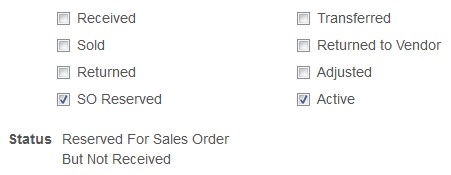
The following table explains each flag:
| Flag | Description |
|---|---|
| Active | Indicates the number can be listed on a document. |
| Sold | Indicates the number was listed on a sales receipt. |
| Returned | Indicates the number was listed on a return receipt. |
| Received | Indicates the number was listed on a receiving voucher. If the Received flag is not selected and the SN is entered on a transaction, a warning will be displayed explaining that the number is an "Unknown State." |
| Returned to Vendor | Indicates the number was listed on a return voucher. |
| Adjusted | Indicates the number was listed on an adjustment memo. |
| SO Reserved | Indicates the number was listed on a sales order but has not yet been received. |
Serial Number Quantity
Serial numbers will typically have one of the following quantity values:
| Qty | Description |
|---|---|
| 1 | The quantity after the serial number has been received into inventory, but before it has been sold. |
| 0 | The quantity after the serial number has been sold. |
| -1 | If a serial number is sold before it is received into inventory, the quantity will be -1. |
Serial/Lot Numbers on Adjustment Memos
The process of entering serial and lot numbers on quantity adjustment memos is different from other documents. This is because the user could be adjusting the quantity up or down.
- Scan the item's UPC to list it on the adjustment memo.
- Select the item and click Item Details.
- Select the Serial Numbers (or Lot Numbers) tab.
- Select the desired number and then click Select Serial.

- Click OK.
- Navigate to Memo Details and make sure a Reason for the memo is entered.
Entering Adjusted Quantity on Details tab
On the Details tab, users can enter the Adjusted Quantity for the item. Users can then click the Lot Numbers tab and enter the number(s) for the units being adjusted.
Adjustment Quantities for Serial Numbers
In Item Details on the Serial tab, you can view information about the item and serial number quantities added and/or deactivated on the quantity memo.

Serial Number fields on Memos
| Field | Description |
|---|---|
| Old Quantity | The quantity for the item at the time of memo creation. |
| Adjusted Quantity | The quantity for the item after the current adjustment is made. |
| Quantity Difference | The difference between the Old Quantity and Adjusted Quantity. |
| Inserted SN Quantity | The number of serial numbers added on this adjustment for the item. |
| Deactivated SN Quantity | The number of serial numbers deactivated on this adjustment for the item. |
| SN Quantity Differences | The difference between the Inserted SN Quantity and the Deactivated SN Quantity. |
Resolving SN/LN Discrepancies
In Admin Console > Node Preferences > Inventory > Serial/Lot, are preferences labeled "Allow Serial Number Discrepancies." There is a similar preference for lot numbers: "Allow Lot Number Discrepancies."
If the preference "Allow Serial Number (or Lot Number) Discrepancies" is NOT selected and there are discrepancies, then the user is informed that the discrepancies must be resolved before the PI can be updated.
If the preference IS selected, the user can update the PI without resolving the discrepancies.
What is a "discrepancy"? A discrepancy is a missing number. For example, if a serial number item is entered on the PI sheet with a quantity of "1" but no serial number is entered, that is a discrepancy. In this case, entering a single serial number will resolve the discrepancy. If multiple numbers are missing, each missing number must be entered to resolve the discrepancy.
Serial/Lot Numbers on Transfers
This section has information about entering serial and lot numbers on transfers. Special care must be taken to make sure that the necessary vendor information is entered on the transfer and receiving documents.
Serial and Lot Numbers on Transfer Orders
Serial and lot numbers are not entered on transfer orders. If the transfer order has serial or lot number items, when a user generates slips from the TO, a message informs that because of the serial/lot items, the slip has been placed on hold.

Pending Transfer Slips
If slips are generated from a TO with serial/lot items, the slip is placed on hold. To unhold a slip and enter the required serial/lot numbers, navigate to Store Operations > Transfers > Pending Transfer Slips. Search for the slip. Select the slip and click OK. The pending slip will have a separate line item for each unit that requires a number. Click the Unhold button on the bottom menu. Select one of the line items that requires a serial/lot number and click Item Details.
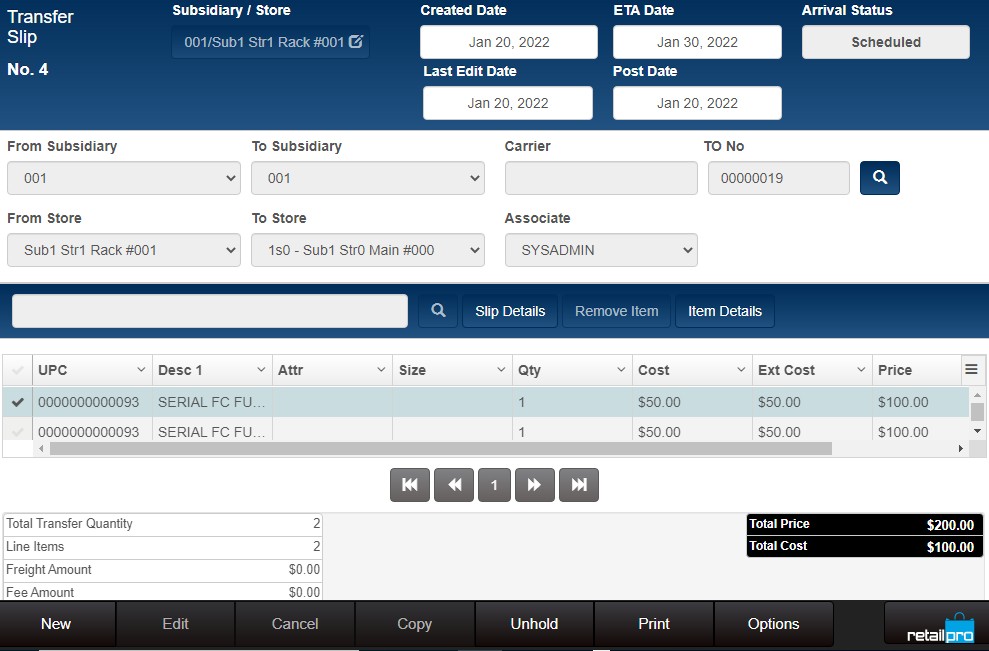
In Item Details, click in the Serial No or Lot No field and scan the bar code for the number. Alternatively, click the Search icon to display a list of available serial/lot numbers. Click OK to return to the pending slip.
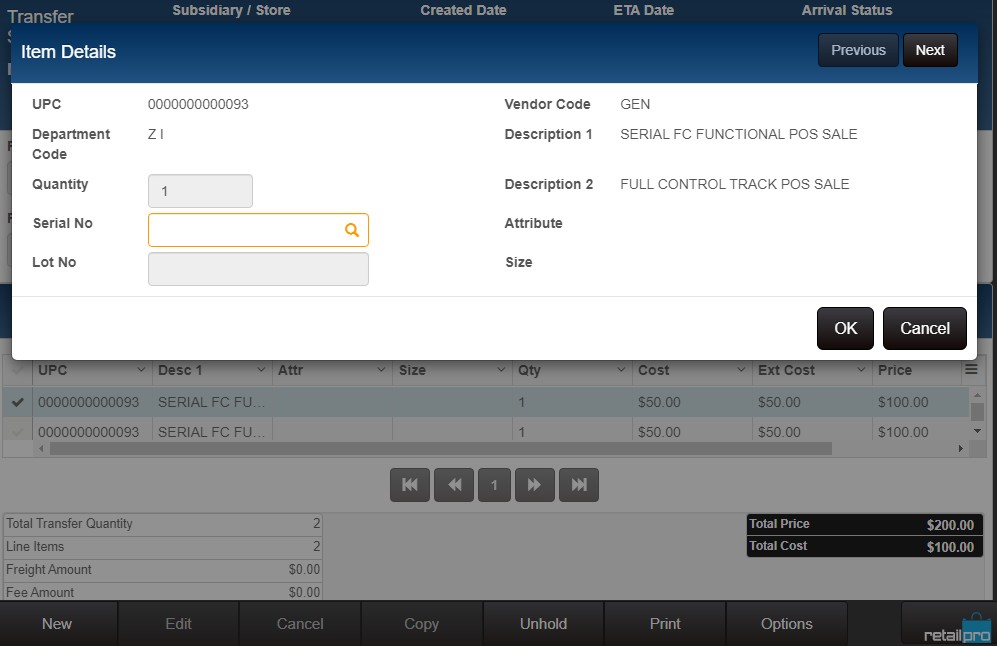
After the slip is unheld and all required numbers have been entered, update the slip. When a transfer slip is updated, the slip decrements the on-hand quantity for the source store. The same slip also decrements the on-hand quantity for the serial number and sets the Status to "transferred." The rest of the process is performed by receiving a transfer voucher or performing transfer verification. When a transfer ASN is generated by a slip, the inventory on-hand quantity does not change, but a new record with zero quantity is added for that serial number in the target store (and the modified date of that serial number is updated). When a transfer voucher is created from the transfer ASN, the on-hand quantity for the item and serial number are incremented.
Serial and Lot Number Items and Sublocations
You can assign serial and lot numbers to sublocations and then pull the serial/lot numbers from those sublocations when listing the SN/LN items on documents. For example:
- A retailer has a high-security sublocation within a store for storing electronics.
- Separate sublocations are used for items that have a particular lot number or expiration date. This is useful for distinguishing which items to use first.
If a serial/lot number item is listed on a receipt or other document, the normal dialog for entering a serial/lot number is displayed. When you return to the receipt with the item, the item will be pulled from the sublocation assigned to that document type in Admin Console > Node Preferences > System > Default Sublocations.
Change the Sublocation for a SN/LN Item on a Document
You can change the sublocation by selecting the item in the Item List and clicking Item Details button. Navigate to the Sublocation dropdown. If the item is a serial or lot number item, a prompt is displayed for entering the serial/lot number(s).
View Serial/Lot Numbers by Sublocation
Click the Serial Numbers or Lot Numbers button on the Inventory Item Details > General tab.
Select a Sublocation from the dropdown. Serial numbers assigned to that sublocation are displayed.

